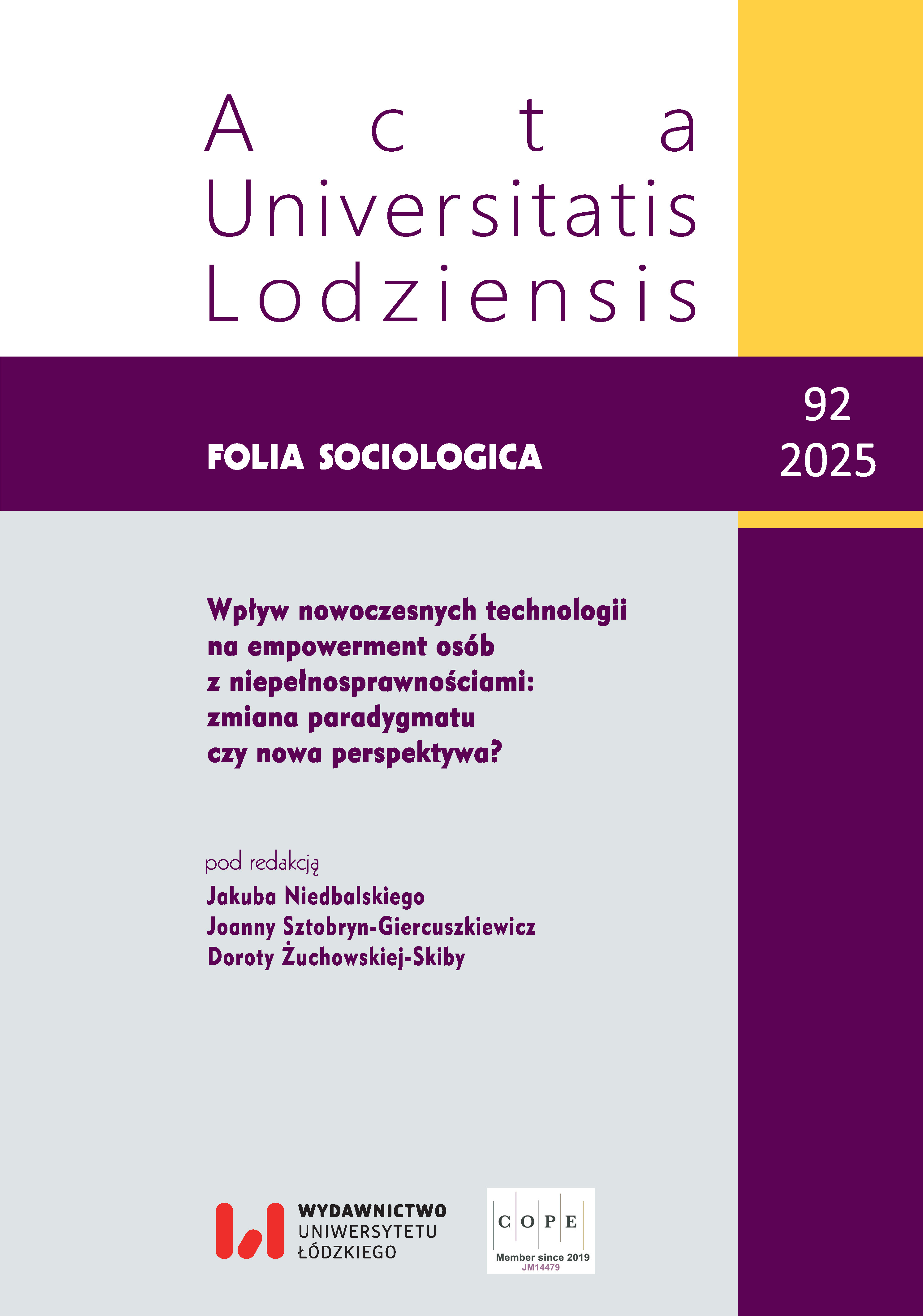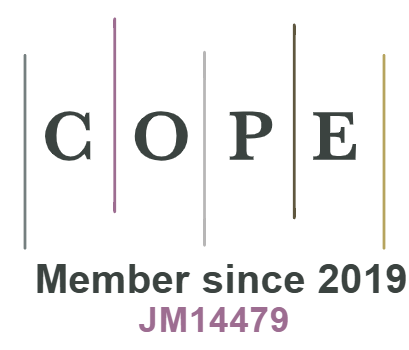Przegląd technologii asystujących w krajach Zatoki Perskiej: potrzeby, kierunki rozwoju i wyzwania
DOI:
https://doi.org/10.18778/0208-600X.92.07Słowa kluczowe:
niepełnosprawność w islamie, technologie asystujące, awatary migające, niepełnosprawność w krajach Zatoki Perskiej, język arabski w technologiach asystującychAbstrakt
W artykule analizowane są technologie asystujące w kontekście krajów Zatoki Perskiej z uwzględnieniem ich wpływu na sytuację osób z niepełnosprawnościami. Postrzeganie niepełnosprawności jest ściśle związane z kontekstem kulturowym i religijnym, co wpływa na skuteczność narzędzi wspomagających. W społeczeństwach muzułmańskich odpowiedzialność za osoby z niepełnosprawnościami spoczywa głównie na rodzinie, co często prowadzi do ich marginalizacji. Artykuł ilustruje, jak nowoczesne technologie mogą przyczynić się do emancypacji osób z niepełnosprawnościami, zwłaszcza w kontekście ograniczeń związanych z normami społecznymi i religijnymi. Metodologia badania opiera się na studiach przypadków, które ilustrują działanie technologii asystujących dostosowanych do lokalnych potrzeb i kultury w krajach Zatoki Perskiej. Celem jest ukazanie specyfiki regionu oraz wyzwań związanych z implementacją technologii asystujących w arabskich społecznościach Zatoki Perskiej, a także ich potencjału w poprawie jakości życia osób z niepełnosprawnościami. Znaczenie dostosowania technologii wspomagających skierowanych do osób z niepełnosprawnościami do określonych kontekstów językowych i kulturowych nabiera dziś coraz większego znaczenia. Technologie asystujące i ich wykorzystanie przez osoby z niepełnosprawnościami zależą nie tylko od funkcjonalności, jakie dana technologia posiada, ale również od tego, czy jest ona dostoswana do kontekstu kulturowego, w którym ma funkcjonować. Zagadnienie to jest przede wszystkim ważne przy technologiach, które dotyczą przetwarzania języka. Język arabski jest w swej strukturze odmienny od języków dominujących w technologiach asystujących, zatem technologie skoncentrowane na barierach komunikacyjnych muszą być w społeczeństwie arabskim odmienne.
Bibliografia
Al Thani H. (2006), Disability in the Arab region: Current situation and prospects, „Behinderung und Dritte Welt, Journal for Disability and International Development”, nr 3, s. 12–16.
Google Scholar
Alanazi M.S. (2023), Innovation for all: Unleashing the power of assistive technology in special education in Arabic-speaking countries „Journal of ICSAR”, t. 7(2), s. 115–120.
Google Scholar
DOI: https://doi.org/10.17977/um005v7i22023p178
Al-Aoufi H., Al-Zyoud N., Shahminan N. (2012), Islam and the cultural conceptualisation of disability, „International Journal of Adolescence and Youth”, t. 17(4), s. 205–221. https://doi.org/10.1080/02673843.2011.649816
Google Scholar
DOI: https://doi.org/10.1080/02673843.2011.649565
Aldosari H. (2017), The effect of gender norms on women’s health, „Saudi Arabia Policy Paper”, nr 1/17.
Google Scholar
Almekhalfi A.G., Tibi S. (2012), The use of Assistive Technology for people with special needs in the UAE, „Journal of International Special Needs Education”, t. 15(1), s. 56–67. https://doi.org/10.9782/2159-4341-15.1.56
Google Scholar
DOI: https://doi.org/10.9782/2159-4341-15.1.56
A l-M u n a j j i d M.S. (1999), Guidelines on the issue of: Looking for the purposes of medical treatment, „Islam Question & Answer”, https://islamqa.info/ar (dostęp: 11.12.2024).
Google Scholar
A l-S h a m a y l e h A.S., R o d i n a A., N a z e a n J., A b u s h a r i a h M. (2020), Language resources for Maghrebi Arabic dialects’ NLP: A survey, „Language Resources and Evaluation”, t. 54(4), s. 893–915. https://doi.org/10.1007/s10579-020-09475-2
Google Scholar
Aziz M., Othman A. (2023), Evolution and trends in sign language avatar systems: Unveiling a 40-year journey via systematic review „Multimodal Technologies and Interaction”, t. 7(10), 97.
Google Scholar
DOI: https://doi.org/10.3390/mti7100097
Bazna M., Hatab T.A. (2005), Disability in the Qur’an: The Islamic alternative to defining, viewing, and relating to disability, „Journal of Religion, Disability & Health”, t. 9(1), s. 5–25. https://doi.org/10.3390/mti7100097
Google Scholar
DOI: https://doi.org/10.1300/J095v09n01_02
Bell D., Layton N., Smith R.O., Scherer M.J., Smith E.M. (2024), Developing a holistic process to measure assistive technology outcomes, „Assistive Technology Outcomes and Benefits”, t. 18, s. 1–15.
Google Scholar
Benmarrakchia F., El Kafia J., Elhore A. (2017), Communication technology for users with specific learning disabilities, „Procedia Computer Science”, nr 110, s. 462–468. https://doi.org/10.1016/j.procs.2017.06.093
Google Scholar
DOI: https://doi.org/10.1016/j.procs.2017.06.093
Bennett A., Elman C. (2006), Qualitative research: Recent developments in the case study methods, „Annual Review of Political Science”, nr 9, s. 455–476. https://doi.org/10.1146/annurev.polisci.8.082103.104918
Google Scholar
DOI: https://doi.org/10.1146/annurev.polisci.8.082103.104918
Borg J., Larsson S., Östergren P.O. (2011), The right to assistive technology: For whom, for what, and by whom?, „Disability & Society”, t. 26(2), s. 151–167. https://doi.org/10.1080/09687599.2011.543862
Google Scholar
DOI: https://doi.org/10.1080/09687599.2011.543862
Bunge M. (2004), How does it work?: The search for explanatory mechanisms, „Philosophy of the Social Sciences”, nr 34, s. 182–210. https://doi.org/10.1177/0048393103262550
Google Scholar
DOI: https://doi.org/10.1177/0048393103262550
Danecki J. (2011), Podstawowe wiadomości o islamie, Wydawnictwo Dialog, Warszawa.
Google Scholar
Desmond D., Layton N., Bentley J., Boot F.C., Borg J., Dhungana B.M. (2018), Assistive technology and people: A position paper from the first global research, innovation and educatio on assistive technology (GREAT) summit, „Disability and Rehabilitation: Assistive Technology”, t. 13(5), s. 437–445. https://doi.org/10.1080/17483107.2018.1471169
Google Scholar
DOI: https://doi.org/10.1080/17483107.2018.1471169
Elsheikh A. (2023), Enhancing the efficacy of assistive technologies through localization: A comprehensive analysis with a focus on the Arab region, „Nafath”, t. 8(23), s. 44–50.
Google Scholar
Farghaly A., Shaalan K. (2009), Arabic natural language processing: Challenges and solutions, „ACM Transactions on Asian Language Information Processing”, t. 8(4), s. 1–22. https://doi.org/10.1145/1644879.1644881
Google Scholar
DOI: https://doi.org/10.1145/1644879.1644881
Fteiha M., Al-Rashaida M., Elsori D., Khalil A., Al Bustami K. (2024), Obstacles for using assistive technology in centres of special needs in the UAE, „Disability and Rehabilitation: Assistive Technology”, s. 1–8. https://doi.org/10.1080/17483107.2024.1001875
Google Scholar
DOI: https://doi.org/10.1080/17483107.2024.2323698
Gadgil S., Predictable Arabic, Mada Innovation Program, https://mip.mada.org.qa/solution/predictable-arabic/ (dostęp: 17.12.2024).
Google Scholar
Gulf News Report (2024), Dubai to showcase assistive technologies for the first time in region this November, https://www.zawya.com/en/press-release/companies-news/dubai-to-showcase-impressive-range-of-new-assistive-technologies-for-the-first-time-in-the-region-this-november-c2nm4zq6 (dostęp: 17.12.2024).
Google Scholar
Habash N.Y. (2022), Introduction to Arabic natural language processing, Springer. https://doi.org/10.1007/978-3-030-66430-9
Google Scholar
DOI: https://doi.org/10.18653/v1/2022.emnlp-tutorials.2
Hasnain R., Shaikh L.C., Shanawani H. (2008), Disability and the Muslim Perspective: An Introduction for Rehabilitation and Health Care Providers, Center for International Rehabilitation Research Information and Exchange.
Google Scholar
Hopkyns S., Elyas T. (2022), Arabic vis-à-vis English in the Gulf Bridging the ideological divide, [w:] S. Hopkyns, W. Zoghbor (red.), Linguistic Identities in the Arab Gulf States Waves of Change, Routledge, London, s. 17–32. https://doi.org/10.4324/9781003149637-3
Google Scholar
DOI: https://doi.org/10.4324/9781003149637-3
Huer Blake M. (2000), Examining perceptions of graphic symbols across cultures: Preliminary study of the impact of culture/ethnicity, „Augmentative and Alternative Communication”, t. 16(3), s. 180–185. https://doi.org/10.1080/07434610012331279034
Google Scholar
DOI: https://doi.org/10.1080/07434610012331279034
Ibrahim I., Ismail M.F. (2017), Muslims with disabilities: Psychosocial reforms from an Islamic perspective, „Journal of Disability & Religion”, t. 22(1), s. 50–67. https://doi.org/10.1080/23312521.2017.1266985
Google Scholar
DOI: https://doi.org/10.1080/23312521.2017.1351327
Jaballah K., Jemni M. (2013), A review on 3D signing avatars: Benefits, uses and challenges, „International Journal of Multimedia Data Engineering and Management”, t. 4(1), s. 24–34. https://doi.org/10.4018/ijmdem.2013010103
Google Scholar
DOI: https://doi.org/10.4018/jmdem.2013010102
Layton N., MacLachlan M., Smith R.O., Scherer M. (2020), Towards coherence across global initiatives in assistive technology, „Disability and Rehabilitation: Assistive Technology”, 15(7), s. 711–725. https://doi.org/10.1080/17483107.2019.1587018
Google Scholar
DOI: https://doi.org/10.1080/17483107.2020.1817162
Layton N., Bell D., Buning M.E., Chen S.C., Contepomi S., Ramos V.D., Hoogerwerf V., Inoue E.J., Moon T., Seymour N., Smith R.O., de Witte L. (2020), Opening the GATE: Systems thinking from the global assistive technology alliance, „Disability and Rehabilitation: Assistive Technology”, t. 15(5), s. 561–572. https://doi.org/10.1080/17483107.2019.1587017
Google Scholar
DOI: https://doi.org/10.1080/17483107.2020.1738565
Maisikeli S.G. (2023), Level of assistive technology use and awareness among people with physical disability in the United Arab Emirates, „Technology and Disability”, t. 35(1), s. 15–28. https://doi.org/10.3233/TAD-220001
Google Scholar
DOI: https://doi.org/10.3233/TAD-220393
Mielcarek P. (2014), Metoda case study w rozwoju teorii naukowych, „Organizacja i Kierowanie”, nr 1(161), s. 83–95.
Google Scholar
Nadji A.Z., Boudour R. (2022), ʽIntel Acatʼ assistive platform for Arabic speaking disabled people: A complete integration, „Medical Archives”, t. 76(2), s. 111–117. https://doi.org/10.5455/medarh.2022.76.111-117
Google Scholar
DOI: https://doi.org/10.5455/medarh.2022.76.140-146
Othman A., El Ghoul O. (2022), BuHamad – The first Qatari virtual interpreter for Qatari Sign Language, „Nafath”, t. 7(20), s. 65–73.
Google Scholar
DOI: https://doi.org/10.54455/MCN.20.01
Othman A., Chemnad K., Hassanien A.E., Tlili A., Zhang C.Y., Al Thani D., Altinay F., Chalghoumi H.S., Al-Khalifa H., Obeid M., Jemni M., Al-Hadhrami T., Altinay Z. (2024), Accessible Metaverse: A theoretical framework for accessibility and inclusion in the Metaverse, „Multimodal Technologies and Interaction”, t. 8(21), s. 34–50. https://doi.org/10.3390/mti8030021
Google Scholar
DOI: https://doi.org/10.3390/mti8030021
PCC (2023), Kraje Zatoki Perskiej: Nowy wymiar biznesu i innowacji, https://pcc.org.pl/kraje-zatoki-perskiej-nowy-wymiar-biznesu-i-innowacji/ (dostęp: 3.01.2025).
Google Scholar
Predictable (Therapy Box), https://apps.apple.com/gb/app/predictable/id404445007 (dostęp: 20.12.2024).
Google Scholar
Ragin C.C., Becker H.S. (1992), What is a Case? Exploring the Foundations of Social Inquiry, Cambridge University Press.
Google Scholar
Ripat J., Woodgate R. (2010), The intersection of culture, disability and assistive technology, „Disability and Rehabilitation: Assistive Technology”, t. 6(2), s. 89–96. https://doi.org/10.3109/17483100903576946
Google Scholar
DOI: https://doi.org/10.3109/17483107.2010.507859
Rooshey H., Shaikh L.C., Shanawani H. (2008), Disability and the Muslim Perspective: An Introduction for Rehabilitation and Health Care Providers, Center for International Rehabilitation Research Information and Exchange.
Google Scholar
Saad M.A.E., Borowska-Beszta M. (2019), Disability in the Arab world: A comparative analysiswithin culture, „International Journal of Psycho-Educational Sciences”, t. 8(2), s. 79–94.
Google Scholar
Selina K., Zhang Z., Adnan Y., Alhumaid M. (2024), Disability research in Arab countries: A bibliometric analysis, „JDR”, t. 3(2), s. 45–58.
Google Scholar
DOI: https://doi.org/10.57197/JDR-2024-0004
Shahid Y. (2021), Digital Technology and Inequality: The Impact on Arab Countries, Economic Research Forum (ERF).
Google Scholar
UN Economic and Social Commission for Western Asia (2018), Disability in the Arab Region, https://www.unescwa.org/publications/disability-arab-region-2018 (dostęp: 3.01.2025).
Google Scholar
Walsh A. (2023), How the Gulf region is planning for a life after oil, https://www.dw.com/en/how-the-gulf-region-is-planning-for-a-life-after-oil/a-67067995 (dostęp: 3.01.2025).
Google Scholar
Younes J., Souissi E., Achour H., Ferchichi A. (2020), Language resources for Maghrebi Arabic dialects’ NLP: A survey, „Language Resources & Evaluation”, t. 54(4), s. 893–915. https://doi.org/10.1007/s10579-020-09475-2
Google Scholar
DOI: https://doi.org/10.1007/s10579-020-09490-9
Zaaeed N. (2014), Accessibility, acceptance, Islamic education: Living as a Muslim with disability, https://muslimmatters.org/2014/03/04/living-as-a-muslim-with-disability/ (dostęp: 3.01.2025).
Google Scholar
Opublikowane
Jak cytować
Numer
Dział
Licencja

Utwór dostępny jest na licencji Creative Commons Uznanie autorstwa – Użycie niekomercyjne – Bez utworów zależnych 4.0 Międzynarodowe.










